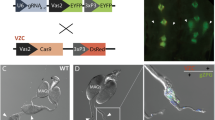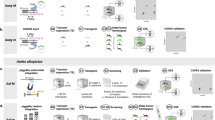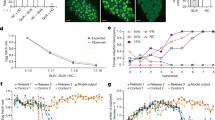Abstract
DURING the course of an experiment to assess the efficiency of a breeding system to detect visible and lethal mutants on chromosome 3, a dominant, temperature-sensitive lethal (DTS) was discovered in the mosquito, Culex tritaeniorhynchus Giles, an important arbovirus vector. This DTS lethal, designated L(3)1DTS but here referrred to as DTS-1, survives at 26 °C but dies at 32 °C during the larval stages. It was recovered after treatment with 0.005 M ethyl methanesulphonate (EMS). The isolation of a sex-linked DTS in a vector species of medical or agricultural importance may be valuable as a sexing device in a release programme involving either males sterilised directly by radiation or chemosterilants or males carrying genetic aberrations that give high semisterility.
This is a preview of subscription content, access via your institution
Access options
Subscribe to this journal
Receive 51 print issues and online access
$199.00 per year
only $3.90 per issue
Buy this article
- Purchase on Springer Link
- Instant access to full article PDF
Prices may be subject to local taxes which are calculated during checkout
Similar content being viewed by others
References
Klassen, W., Creech, J. F. & Bell, R. A., USDA Misc. Publ. 1178, 77 (1970).
Klassen, W., Knipling, E. F. & McGuire, Jr, J. U. A. Entomol. Soc. Am. 63, 238–255 (1970).
Curtis, C. F. Nature 218, 368–369 (1968).
Suzuki, D. T. Science 170, 695–706 (1970).
Smith, R. H. & von Borstel, R. C. Science 178, 1164–1174 (1972).
Wehrhahn, C. F. & Klassen, W. Can. Ent. 103, 1337–1339 (1971).
Whitten, M. J. Science 171, 682–684 (1971).
McDonald, I. C. & Overland, D. E. J. econ. Ent. 65, 1364–1368 (1972).
Sakai, R. K. & Baker, R. H. Mosq. News 34, 420–424 (1974).
Curtis, C. F., Akiyama, J. & Davidson, G. Mosq. News 36, 492–498 (1976).
Sakai, R. K. & Baker, R. H. Genetics 71, 287–296 (1972).
Baker, R. H., Sakai, R. K. & Saifuddin, U. T. Mosq. News 37, 681–686 (1977).
Baker, R. H. & Sakai, R. K. J. Hered. 67, 289–294 (1976).
Baker, R. H., Saifuddin, U. T. & Sakai, R. K. Jap. J. Genet. 52, 425–430 (1977).
Baker, R. H., Sakai, R. K., Iqbal, M. P. & Lateef, S. Mosq. News 36, 349–354 (1976).
Sakai, R. K., Baker, R. H. & Iqbal, M. P. J. Hered. 67, 103–108 (1976).
Author information
Authors and Affiliations
Rights and permissions
About this article
Cite this article
BAKER, R., SAKAI, R. & SAIFUDDIN, U. Genetic sexing technique for a mosquito sterile male release. Nature 274, 253–255 (1978). https://doi.org/10.1038/274253a0
Received:
Accepted:
Published:
Issue Date:
DOI: https://doi.org/10.1038/274253a0
This article is cited by
-
Construction of a genetic sexing strain for Aedes albopictus: a promising tool for the development of sterilizing insect control strategies targeting the tiger mosquito
Parasites & Vectors (2018)
-
Genetic sex separation of the malaria vector, Anopheles arabiensis, by exposing eggs to dieldrin
Malaria Journal (2012)
-
10.1007/BF00302788
CrossRef Listing of Deleted DOIs (2011)
-
A male-linked translocation with high fertility in the onion fly Hylemya antiqua (Meigen)
Genetica (1980)
Comments
By submitting a comment you agree to abide by our Terms and Community Guidelines. If you find something abusive or that does not comply with our terms or guidelines please flag it as inappropriate.



